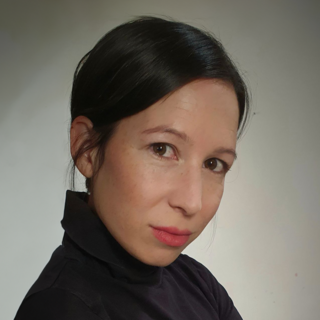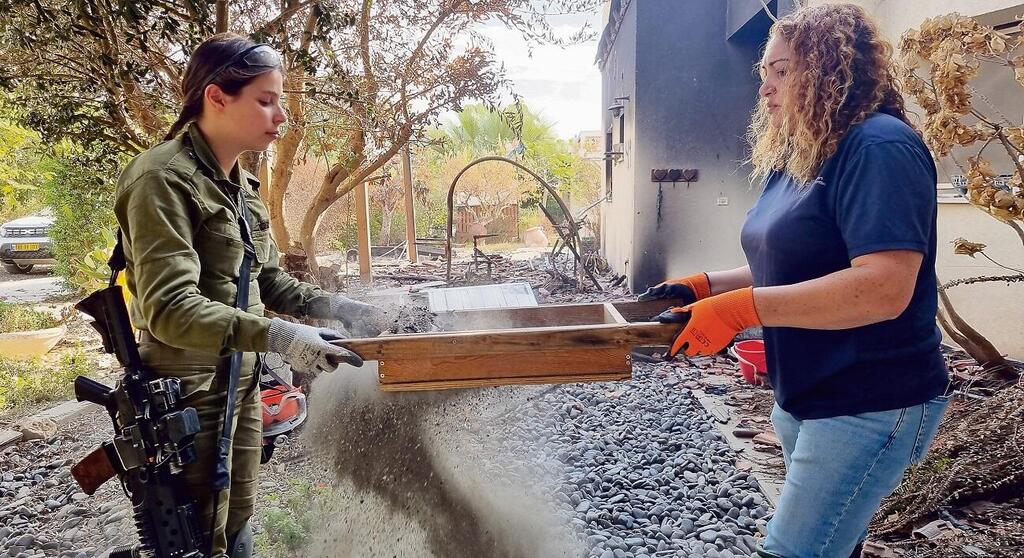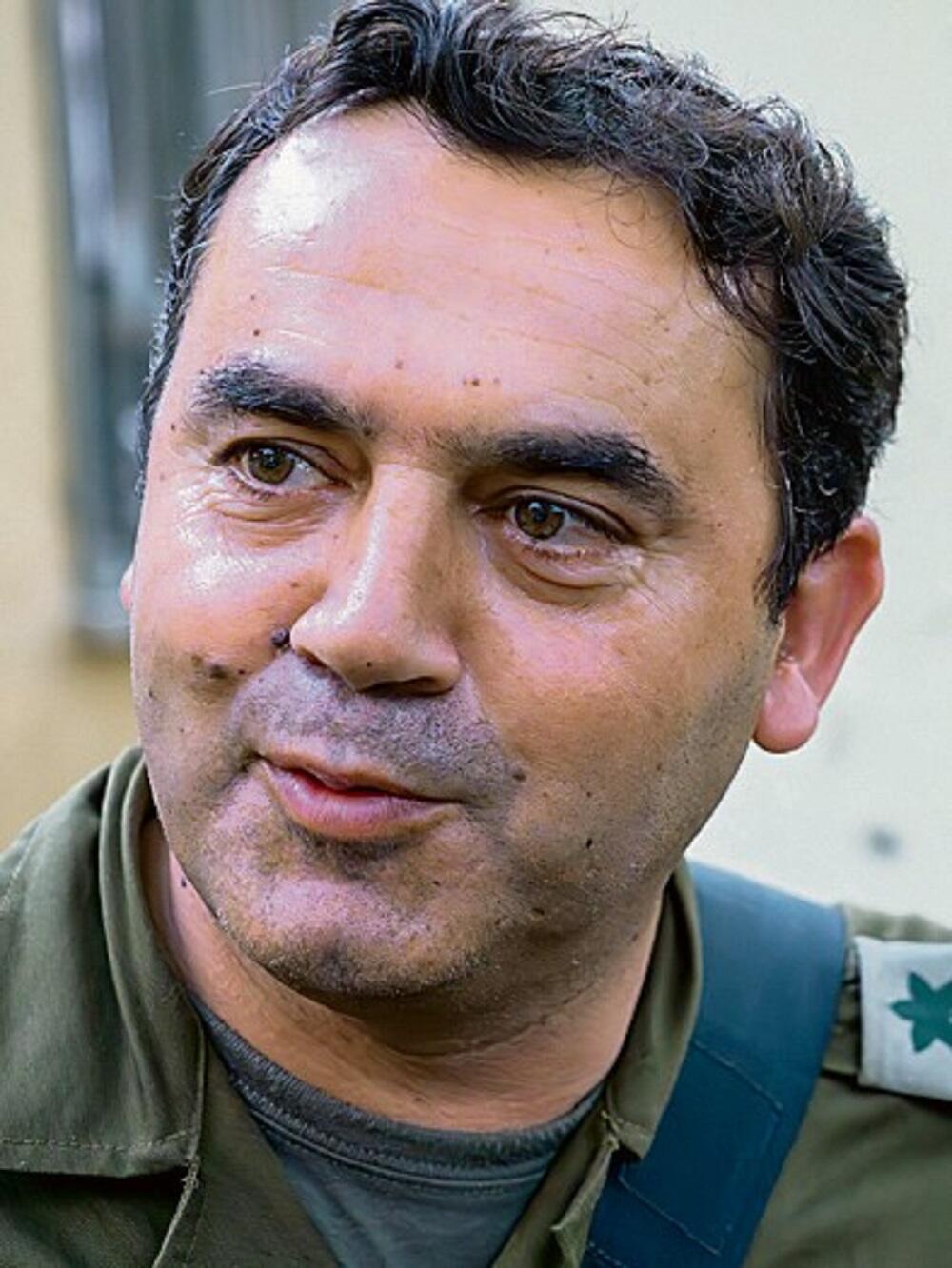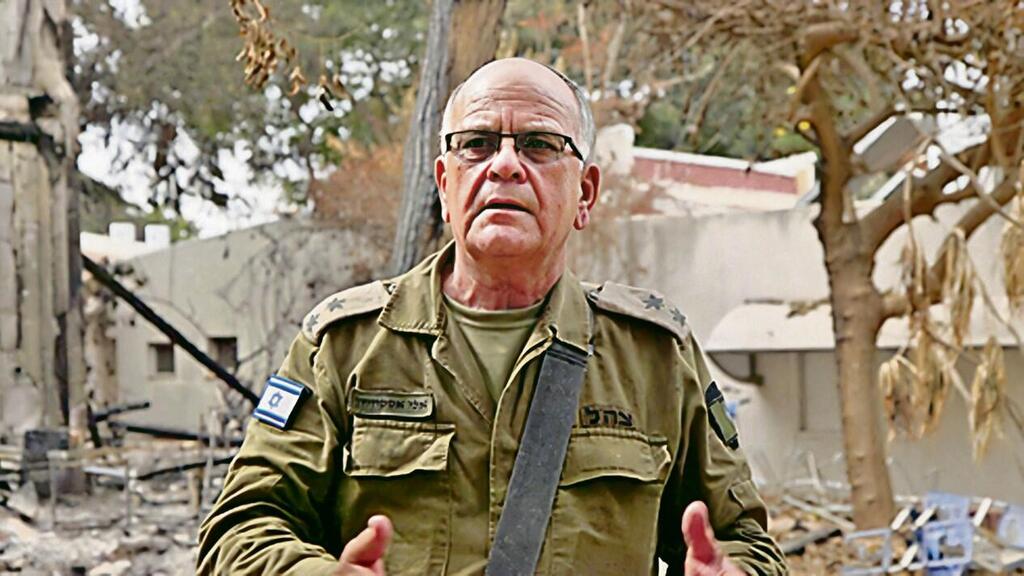In a Kibbutz Re’im parking lot, where hundreds of Israelis attending a music festival were massacred by Hamas on October 7, a burning vehicle is lying on its side in a charred patch of ground. In front of it stand military officers, soldiers and archaeologists from the Israel Antiquities Authority (IAA). "It's an ambulance the terrorists set on fire," explains an officer from the IDF’s Missing Persons Unit.
More stories:
"During initial scans, a number of charred bodies were found inside and around the vehicle. Beneath the ambulance, we found the remains of three additional individuals, individuals who hid from the terrorists and were burned alive. The findings involve spines, hip bones and some tissue samples. But some questions arose about additional victims here. We’ll let the archaeologists do what they know best."
5 View gallery
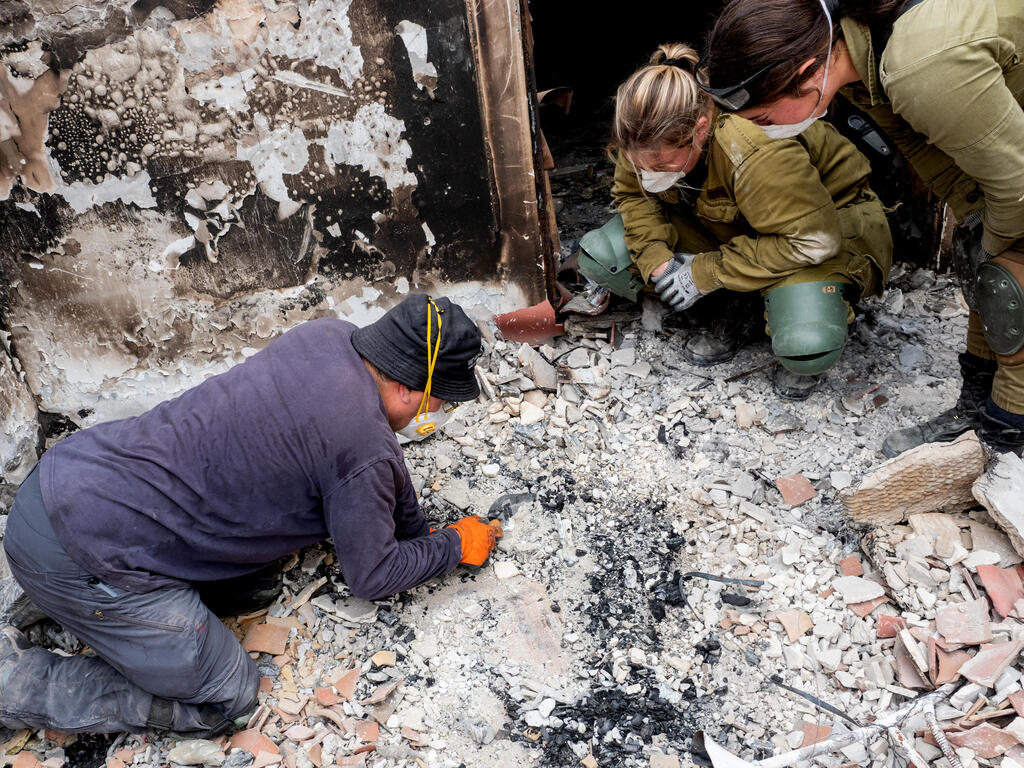

Archaeologist looking through ruins
(Photo: Asaf Perez, Israel Antiquities Authority)
After a few minutes, the area is parceled into several sections, and archaeologists kneel down, filling buckets with gravel. They specialize in dealing with ruins, but the ruins they’re accustomed to are ancient, and this time, they’re scenes of destruction and death from just a few weeks ago.
Remains beneath the ashes
"In archaeological excavations, you don't have smells, you don't have blood, you don't have color. Everything is black and white," says Dr. Ayelet Dayan, head of the IAA’s archaeological research department. "You also don't know the people who were there. After all, 2,000 years have passed. It's not emotional. But now you're in a place that was a paradise until recently and witness its destruction."
Slowly, discoveries are made beneath the ash-filled earth: a necklace with a pendant, a bracelet, a ring, earrings and coins. The archaeologists explain to the soldiers helping them what bone fragments look like, and there are so many of them here. I, too, sift through some of the gravel and find small, fragile bone fragments.
Back in November, two days before the searches through the parking area, Colonel (res.) Yossi Cohen sent a message to all those taking part in the task. He’s the commander of the Avodat Kodesh unit in the Gaza Division, established at the beginning of the war, dealing with collecting information about the location of bodies, evacuating the fallen and collecting findings to aid identification of victims. "Every bone, tooth and find, turn into a person, a name, a grave where the family can come together and mourn," he wrote.
The involvement of IAA experts in the mission testifies to the extent of the destruction and devastation of Hamas’ attack. Their enlistment for the mission came out of necessity, creativity and goodwill.
Cohen, 49, a resident of Kfar Maimon close to the Gaza Strip, woke up on that Saturday to the sound of rocket sirens. "From the intensity of the rocket fire, I quickly realized this was something completely different," he says.
Shortly afterward, he received a call saying he was taking charge of the IDF’s Home Front Command’s Southern District Command as its chief was wounded in clashes with terrorists. Cohen agreed. "I started overseeing the activation of emergency procedures and mobilizing the entire district, 6,000 reservists," Cohen explains. "But on that same evening, the district’s chief returned from the hospital and took charge again."
At this stage, casualties were being evacuated from the scene, including hundreds of bodies. "I opened a WhatsApp group with of all the relevant bodies, and we began to manage the evacuation in an organized manner," Cohen recalls.
"I feel that this is my life’s mission," he says. "Everything I went through, from the time I was a child to becoming a commander in the IDF, prepared me for this war. From the first day of the war, the IDF and Gaza Division declared locating all missing persons was a main goal. We decided to remove all of the terrorists’ bodies from the sector so there would be no misidentifications.”
“The scenes in the field were very hard to bear. People risked their lives for a great cause: bringing everyone to a proper burial in Israel," he adds.
A few days later, Cohen called IAA Director-General Eli Escusido. "I called him and said, 'Eli, I need your best archaeologists tomorrow morning in southern Israel.' I explained we were having difficulties with the burned houses, and required the bes experts. The next day, he arrived with 15 archaeologists. Some of the families' loved ones were only discovered thanks to them.”
'One of the hardest days of my life'
Escusido, 66, quickly realized where he was going. In his reserve duty, he serves as the deputy commander of an infantry brigade. On the evening of October 7, he found himself in Kibbutz Be’eri. "The entire area was filled with soldiers and ambulances. We entered. There were still hostages in the dining room, and terrorists in some homes.”
“There were several tanks that were firing constantly, and soldiers went from house to house to rescue the residents. It was an incomprehensible scene," he adds.
The destruction was systematic. "The terrorists didn’t settle for murder and abuse. They burned the houses so that nothing would remain of them, so that there would be no way to identify the victims."
The archaeologists' first site was Kibbutz Kfar Aza. "It was one of the hardest days of my life," says IAA Deputy Director Moshe Ajami. "I walked on the paved path and felt my shoe sticking. Someone told me, 'What are you doing? You're stepping on the blood of a terrorist!' I didn't notice. I then realized where I was, in hell. You see it described on television, you watch some videos, but you don't really understand the extent of the cruelty and monstrosity. It only hit me when we got there."
They work 24/7, from sunrise to sunset, from dusk to dawn. "We don't have weekends," Ajami says. "The military fires all day long. We ignore everything. Our guys don't give up, going from home to home. We know how to identify and locate a bone less than a centimeter in length. We sift through the ashes and collect every tiny fragment we find. We don't want to leave any piece that won't get a proper burial.”
“When we entered one of the burned houses in Be’eri, we received a description of the family's father and the jewelry he wore. It took us ten minutes to find his necklace among the ruins. We sent a photo of the necklace to his son, who was waiting outside the house, and he confirmed it. We also found the man's ring."
How do you cope with these graphic scenes?
"I shut myself off completely. I have a mission, and I must fulfill it. We'll cope when it's done. The mission is so important that you don't allow yourself to think. You see things you never thought you'd see, and you just keep going. All of our staff are like that. From a professional standpoint, the work is similar to an archaeological excavation site. But archaeological excavations are a calming thing, and here, it's hell."
They also arrived in combat zones. In the Kibbutz Mefalsim area, they searched through the remains of five burnt Israeli vehicles. "Two tanks and many combat soldiers accompanied our teams," Ajami says. "There were explosions and gunfire. We worked nonstop. We didn't know what day or time it was. We felt that we were serving the State of Israel.”
“This feeling prevented us from feeling hungry, shaken or recognizing the horrors around us. The best feeling was when they showed me obituaries of the people we helped identify," he adds.
5 View gallery
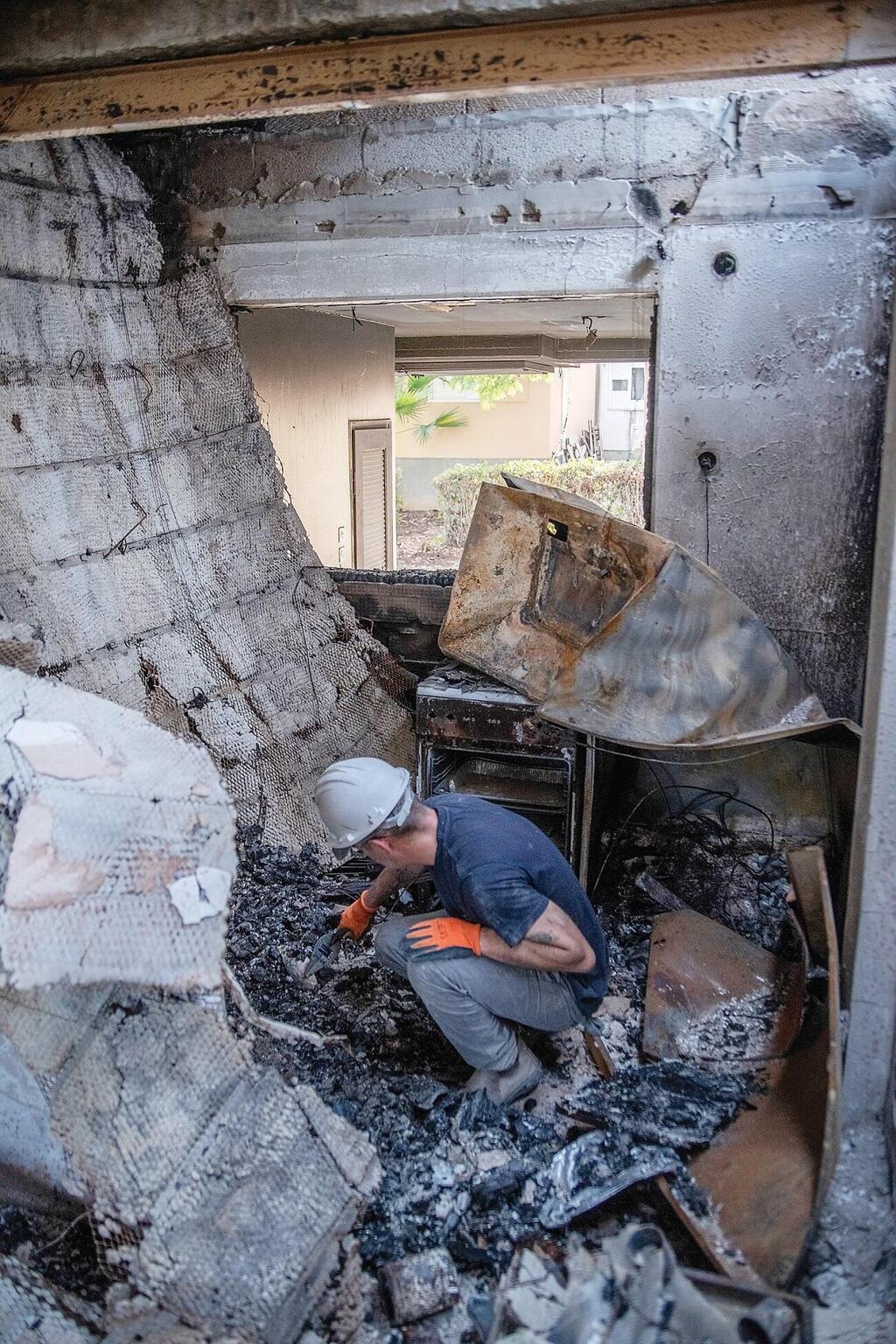

Archaeologist working in Kibbutz Kissufim
(Photo: Shai Halevy, Israel Antiquities Authority)
"We’re all experts in ruin," says Dr. Dayan. "The team has retired archaeologists and those working abroad who requested to come to Israel for this mission.”
"On the fourth day of the war, residents began to come to see if anything was left of their homes, to mourn their families,” she adds. “One of the teams ran into a grandmother who lost her children and grandchildren. She entered the children’s room which was still left with some glow-in-the-dark stickers stuck to the ceiling.”
We arrive at Kibbutz Be’eri. A layer of dust covers the houses and roads. Just a few weeks ago, it was teeming with life. Now the kibbutz looks ancient, a suitable backdrop for the work of an archaeologist.
“One of the reports we received was about a house in Be’eri where 17 people were gathered,” says Escusido. “Some were sitting on the right side, and some on the left. Some were sitting on a sofa, and some were standing. They were all murdered and set on fire. We found piles of bones there. As commanders and managers, we need to remove ourselves emotionally and move forward. If you focus on what happened, you lose direction."



